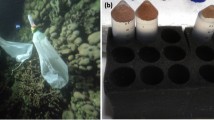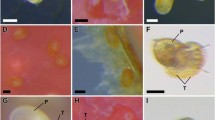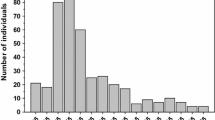Abstract
Balanus subalbidus (Henry) has the most oligohaline distribution of three congeneric barnacles in Chesapeake Bay and tolerates prolonged exposure to fresh water. We studied larval settlement (i.e., permanent attachment and metamorphosis) of B. subaldius in the laboratory, over a 3 yr period, May 1989 to March 1992, under the following conditions: (1) across an array of salinities at 25°C in the presence and absence of settlement factor consisting of adult B. subalbidus extract; (2) in the presence of conspecific or congeneric settlement factors; and (3) cyprids which were, and were not, induced to delay metamorphosis were compared in their capacities to settle in a range of salinities. Discrepancies between salinity profiles of larval settlement in the laboratory and adult oligohaline distribution in the estuary were striking, and there was a significant interaction between salinity and settlement factor. Averaging results of four different batches of larvae, although peak settlement (87±9%) of B. subalbidus occurred at 2 ppt salinity in the presence of adult cue, substantial settlement also occurred at higher salinities: >70% at 5, 10 and 15 ppt; and 47% at 20 and 25 ppt. In addition, settlement in the absence of settlement factor was relatively high (>50%) and peaked at mid-salinity ranges (e.g. 56±10% at 15 ppt). Variation observed in settlement among larval batches reflected detailed differences in settlement between adjacent test salinities. No difference in settlement occurred between replicate aliquots of cyprids within a batch. Cyprids of B. subalbidus settled most abundantly in the presence of settlement factor extracted from conspecifics, followed in decreasing order by settlement factor extracted from B. improvisus and B. eburneus. Delay of metamorphosis produced by keeping B. subalbidus cyprids for 8 d at 5°C resulted in a decreased level of settlement, but settlement frequency patterns of delayed and non-delayed cyprids were indistinguishable relative to salinity. These results indicate that the oligohaline distribution of adult B. subalbidus is probably not determined by larval behavior at settlement. We suggest that pre-settlement behavior, resulting in larval retention in low saline waters, could be an important factor in determining distribution of this species.
Similar content being viewed by others
References
Bousfield EL (1955) Ecological control of the occurrence of barnacles in the Miramichi estuary. Bull natn Mus Can 137:1–69
Branscomb ES (1976) Proximate causes of mortality determining the distribution and abundance of the barnacle Balanus improvisus Darwin in Chesapeake Bay. Chesapeake Sci 17:281–288
Bushek D (1988) Settlement as a major determinant of intertidal oyster and barnacle distributions along a horizontal gradient. J exp mar Biol Ecol 122:1–18
Caffey HM (1985) Spatial and temporal variation in settlement and recruitment of intertidal barnacles. Ecol Monogr 55:313–332
Cain TD (1972) The reproductive cycle and larval tolerances of Rangia cuneata in the James River, Virginia. Ph D dissertation, Univ. Virginia, Charlottesville
Chabot R, Bourget E (1988) Influence of substratum heterogeneity and settled barnacle density on the settlement of cypris larvae. Mar Biol 97:45–56
Connell JH (1985) The consequences of variation in initial settlement vs. post-settlement mortality in rocky intertidal communities. J exp mar Biol Ecol 93:11–45
Crisp DJ (1955) The behavior of barnacle cyprids in relation to water movement over a surface. J exp Biol 32:569–590
Crisp DJ (1988) Reduced discrimination of laboratory reared cyprids of the barnacle, Balanus amphitrite amphitrite Darwin, Crustacea, Cirripedia, with a description of a common abnormality. In: Thompson MF, Serojini, R, Nagebhushanam R (eds) Marine biodegradation. Oxford and I.B.H. Publ Co Ltd. New Delhi, pp 409–432
Crisp DJ (1990) Gregariousness and systematic affinity in some North Carolinian barnacles. Bull mar Sci 47:516–525
Crisp DJ, Barnes H (1954) The orientation and distribution of barnacles at settlement with particular reference to surface contour. J Anim Ecol 23:142–162
Crisp DJ, Meadows PS (1962) The chemical basis of gregariousness in cirripedes. Proc R Soc Lond (Ser B) 156:500–520
Cronin TW (1982) Estuarine retention of larvae of the crab Rhithropanopeus harrisii. Estuar cstl Shelf Sci 15:207–220
Dineen JF Jr, Hines AH (1992) Interactive effects of salinity and adult extract upon settlement of the estuarine barnacle Balanus improvisus (Darwin, 1854). J exp mar Biol Ecol 156:239–252
Dineen JF Jr, Hines AH (in press) Larval settlement of the polyhaline barnacle Balanus eburneus (Gould): cue interactions and comparisons with two estuarine congeners. J exp mar Biol Ecol
Eckman JE, Savidge WB, Gross TF (1990) Relationship between duration of cyprid attachment and drag forces associated with detachment of Balanus amphitrite cyrpids. Mar Biol 107:111–118
Gaines S, Brown S, Roghgarden J (1985) Spatial variation in larval concentration as a cause of spatial variation in settlement for the barnacle, Balanus glandula. Oecologia 67:267–272
Gaines SD, Roughgarden J (1987) Fish in offshore kelp forests affect recruitment to intertidal barnacle populations. Science, NY 235:479–481
Grosberg RK (1982) Intertidal zonation of barnacles: the influence of planktonic zonation of larvae on vertical distribution of adults. Ecology 63:894–899
Henry DP (1973) Descriptions of four new species of the Balanus amphitrite-complex (Cirripedia: Thoracica). Bull mar Sci 23: 964–1001
Henry DP, Melaughlin PA (1975) The barnacles of the Balanus amphitrite complex (Cirripedia: Thoracica). Zool Verh, Leiden 141: 1–254
Holm ER (1990) Attachment behavior in the barnacle Balanus amphitrite amphitrite (Darwin): genetic and environmental effects. J exp mar Biol Ecol 135:85–98
Hopkins SH, Anderson JW, Horvath K (1973) The brackish water clam Rangia cuneata as indicator of ecological effects of salinity changes in coastal waters. US Army Engineer Waterways Experiment Station contract report H-73-1, Vicksburg, Mississippi
Hudon C, Bourget E (1983) An integrated study of factors influencing the choice of the settling site of Balanus crenatus cyprid larvae. Can J Fish aquat. Science 40:1186–1194
Johnson LE, Strathmann RR (1989) Settling barnacle larvae avoid substrata previously occupied by a mobile predator. J exp mar Biol Ecol 128:87–103
Kennedy VS, DiCosimo J (1983) Subtidal distribution of barnacles (Cirripedia: Blanidae) in Chesapeake Bay, Maryland. Estuaries 6:95–101
Keough MJ, Downes BJ (1982) Recruitment of marine invertebrates: the role of active larval choices and early mortality. Oecologia 54:348–352
Knight-Jones EW (1953) Laboratory experiments on gregariousness during settling in Balanus balanoides and other barnacles. J exp Biol 30:584–598
Knight-Jones EW (1955) The gregarious setting reaction of barnacles as a measure of systematic affinity. Nature, Lond 174:266
Lang WH (1979) Larval development of shallow water barnacles of the Carolinas (Cirripedia: Thoracica) with keys to naupliar stages. NOAA tech Rep US Dep Commerce NMFS Circular 421: 1–39
Larman VN, Gabbott PA (1975) Settlement of cyprid larvae of Balanus balanoids and Elminius modestus indcued by extracts of adult barnacles and other marine animals. J mar biol Ass UK 55: 183–190
LeTourneux F, Bourget E (1988) Importance of physical and biological settlement cues used at different spatial scales by the larvae of Semibalanus balanoides. Mar Biol 97:57–66
Maki JS, Rittschof D, Costlow JD, Mittchell R (1988) Inhibition of attachment of larval barnacles, Balanus amphitrite, by bacterial surface films. Mar Biol 97:199–206
Maki JS, Rittschof D, Samuelsson M-O, Szewzyk U, Yule AB Kjelleberg S, Costlow JD, Mitchell R (1990) Effect of marine bacteria and their exopolymers on the attachment of barnacle cypris larvae. Bull mar Sci 46:499–511
Minchinton TE, Scheibling RE (1991) The influence of larval supply and settlement on the population structure of barnacles. Ecology 72:1867–1879
Pawlik JR (1992) Chemical ecology of the settlement of benthic marine invertebrates. Oceanog mar Biol A Rev 30:273–335
Pechenik JA (1990) Delayed metamorphosis by larvae of benthic marine invertebrates: Does it occur? Is there a price to pay? Ophelia 32:63–94
Pechenik JA, Rittschof D, Schmidt AR (1993) Influence of delayed metamorphosis on survival and growth of juvenile barnacles Balanus amphitrite. Mar Biol 115:287–294
Poirrier MA, Partridge MR (1979) The barnacle, Balanus subalbidas, as a salinity bioindicator in the oligohaline estuarine zone. Estuaries 2:204–206
Raimondi PT (1988) Settlement cues and determination of the vertical limit of an intertidal barnacle. Ecology 69:400–407
Rittschof D (1985) Oyster drills and the frontiers of chemical ecology: unsettling ideas. Bull Am malac Union (special edn) 1: 111–116
Rittschof D, Branscomb ES, Costlow JD (1984) Settlement and behavior in relation to flow and surface in larval barnacles, Balanus amphitrite Darwin. J exp mar Biol Ecol 82:131–146
Rittschof D, Hooper IR, Branscomb ES, Costlow JD (1985) Inhibition of barnacle settlement and behavior by natural products from whip corals, Leptogorgia virgulata (Lamarck, 1815). J chem Ecol 11:551–563
Rittschof D, Hooper IR, Costlow JD (1986a) Barnacle settlement inhibitors from sea pansies, Renilla reniformis. Bull mar Sci 39: 376–382
Rittschof D, Maki J, Mitchell R, Costlow JD (1986b) Ion and neuropharmological studies of barnacle settlement. Neth J Sea Res 20:269–275
Roughgarden J, Gaines S, Possingham H (1988) Recruitment dynamics in complex life cycles. Science, NY 241:1460–1466
Roughgarden J, Iwasa Y, Baxter C (1985) Demographic theory for an open marine population with space-limited recruitment. Ecology 66:54–67
SAS Institute, Inc (1985) SAS user's guide. Version 5. SAS Institute Inc., Cary, North Carolina
Shanks AL (1986) Tidal periodicity in the daily settlement of intertidal barnacle larvae and an hypothesized mechanism for the cross-shelf transport of cyprids. Biol Bull mar biol Lab, Woods Hole 170:429–440
Sokal RR, Rohlf FJ (1981) Biometry, 2nd edn. W. H. Freeman and Co., New York
Standing JD, Hooper IR, Costlow JD (1984) Inhibition and induction of barnacle settlement by natural products present in octocorals. J chem Ecol 10:823–834
Strathmann RR, Branscomb ES, Vedder K (1981) Fatal errors in set as a cost of dispersal and the influence of intertidal flora on set of barnacles. Oecologia 48:13–18
Underwood AJ, Fairweather PG (1989) Supple-side ecology and benthic marine assemblages. Trends Ecol Evol 4:16–19
Walker G, Yule AB (1984) Temporary adhesion of the barnacle cyprid: the existence of an antennular adhesive secretion. J mar biol Ass UK 64:679–686
Wethey DS (1986) Ranking of settlement cues by barnacle larvae: influence of surface contour. Bull mar Sci 39:393–400
Yule AB, Walker G (1985) Settlement of Balanus balanoides: the effect of cyprid antennular secretion. J mar biol Ass UK 65: 707–712
Author information
Authors and Affiliations
Additional information
Communicated by J. P. Grassle, New Brunswick
Rights and permissions
About this article
Cite this article
Dineen, J.F., Hines, A.H. Effects of salinity and adult extract on settlement of the oligohaline barnacle Balanus subalbidus . Marine Bioliogy 119, 423–430 (1994). https://doi.org/10.1007/BF00347539
Received:
Accepted:
Issue Date:
DOI: https://doi.org/10.1007/BF00347539




